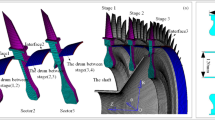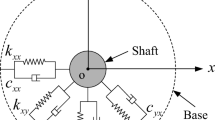Abstract
In this paper, the application of nonlinear energy sinks (NESs) for the vibration suppression of the blades in a flexible shaft–disk–blades system is studied. The system is a simplified model of an industrial steam turbine rotor, which includes a shaft, a disk, and 37 packets of 7-connected blades. A two-level model order reduction is used to obtain the mathematical model of this industrial system. The frequency diagram of the whole system is obtained through the modal analysis of a cyclic symmetric finite element model of a single sector, which is practically the first model reduction. Some new families of flexible shaft–disk–blades system’s natural modes with only two harmonics appear on this diagram that are mostly related to the dynamic of the shaft. Hence, it is nominated for modified SAFE (Singh’s Advanced Frequency Evaluation) diagram in this study. Then, as a second model reduction, a two-degree of freedom reduced-order model of the sector is identified to model the system behavior around the 11th family of natural modes. A strong coupling between rotor components occurs at the first nodal diameter of this mode. The NESs, which consist of a small mass, an essentially nonlinear stiffness, and a linear damping, are mounted on the disk to indirectly suppress the vibration of the blades. Numerical study of system behavior and tuning of NES parameters show that the strongly modulated response occurs near the resonance, and the optimum NESs could effectively reduce the out-of-plane vibration of the blades.

















Similar content being viewed by others
Abbreviations
- \({c}_{b}\) :
-
Blade aerodynamic damping (\(2\pi {\zeta }_{b}\)), N s/m
- \({c}_{N}\) :
-
NES linear damping, \(N s/m\)
- \([E]\) :
-
Fourier transformation matrix
- \(\{{e}_{i}\}\) :
-
ith Column of Fourier matrix
- \({f}_{b}\) :
-
External force applied to the blade, N
- \([K]\) :
-
Sector stiffness matrix
- \([{K}_{c}]\) :
-
Coupling stiffness matrix
- [\(\widetilde{K}\)], [\({\widetilde{K}}_{D}\)]:
-
Stiffness matrices of the system
- \({k}_{b}\) :
-
Blade stiffness, N/m
- \({k}_{c}\) :
-
Inter sector coupling stiffness, N/m
- \({k}_{\rm ds}\) :
-
Disk–shaft stiffness, N/m
- \({k}_{N}\) :
-
NES nonlinear stiffness coefficient, N/m3
- \([M]\) :
-
Sector mass matrix
- [\(\widetilde{M}\)], [\({\widetilde{M}}_{D}\)]:
-
System mass matrices
- \({m}_{b}\) :
-
Blade mass, kg
- \({m}_{\mathrm{ds}}\) :
-
Disk–shaft mass, kg
- \({m}_{N}\) :
-
NES mass, kg
- \(\overline{m }\) :
-
\({m}_{\mathrm{ds}}/{m}_{b}\)
- N :
-
Number of sectors
- R :
-
Disk radius, m
- \({{\varvec{U}}}_{{\varvec{i}}}\) :
-
The ith sector’s DOFs in physical coordinates, m
- \({u}_{N}\) :
-
NES displacement, m
- \({u}_{k, b}\) :
-
Displacement of the blade in the kth modal mode, m
- \({u}_{k, \mathrm{ds}}\) :
-
Displacement of the shaft–disk in the kth modal mode, m
- ϵ :
-
NES mass ratio
- γ b, γ ds :
-
Structural damping ratio of blade and disk–shaft
- \({\kappa }_{d},{\kappa }_{c}\) :
-
Disk and coupling relative stiffnesses
- \({\omega }_{b}\) :
-
Blade bending natural frequency, rad/s
- \({\omega }_{k, n}\) :
-
Frequency of the nth family of natural modes at kth modal mode (or (k − 1)th ND), rad/s
- σ :
-
Frequency detuning parameter
- σ k :
-
Inter-blade phase angle at the kth modal mode of the system
References
Óttarsson G (1994) Dynamic modeling and vibration analysis of mistuned bladed disks
Mead DJ (1975) Wave propagation and natural modes in periodic systems: I Mono-coupled systems. J Sound Vib 40:1–18
Olson BJ, Shaw SW, Pierre C (2005) Order-tuned vibration absorbers for a rotating flexible structure with cyclic symmetry. In: Proceedings of the ASME international design engineering technical conferences and computers and information in engineering conference: DETC2005. pp 2475–2484
Genta G (2007) Dynamics of rotating systems. Springer Science & Business Media
Zhou B, Thouverez F, Lenoir D (2014) Vibration reduction of mistuned bladed disks by passive piezoelectric shunt damping techniques. AIAA J 52(6):1194–1206
Gozen S, Olson BJ, Shaw SW, Pierre C (2012) Resonance suppression in multi-degree-of-freedom rotating flexible structures using order-tuned absorbers. J Vib Acoust 134:61016
Bergeot B, Bellizzi S, Cochelin B (2016) Analysis of steady-state response regimes of a helicopter ground resonance model including a non-linear energy sink attachment. Int J Non Linear Mech 78:72–89
Zhou B, Thouverez F, Lenoir D (2014) Essentially nonlinear piezoelectric shunt circuits applied to mistuned bladed disks. J Sound Vib 333:2520–2542
Singh M (1984) SAFE diagram-a dresser-rand evaluation tool for packeted bladed disc assembly. Technol Rep Dresser-Rand Company, TP025
Kharyton V, Gibert C, Blanc L, Thouverez F (2011) Elements of dynamic characterization of a bladed disk by using the tip-timing method under vacuum conditions. In: ASME 2011 turbo expo: turbine technical conference and exposition. American Society of Mechanical Engineers, pp 1127–1135
Polach P (2011) Evaluation of the suitability of the bladed disk design regarding the danger of the resonant vibration excitation. Eng Mech 18:181–191
API (2014) Standard 612, Special Purpose Steam Turbines for Petroleum. Chem Gas Ind Serv
Chiu Y-J, Li X-Y, Chen Y-C et al (2017) Three methods for studying coupled vibration in a multi flexible disk rotor system. J Mech Sci Technol 31:5219–5229
Bab S, Khadem SE, Shahgholi M (2014) Lateral vibration attenuation of a rotor under mass eccentricity force using non-linear energy sink. Int J Non Linear Mech 67:251–266
Bergeot B, Bellizzi S, Cochelin B (2017) Passive suppression of helicopter ground resonance using nonlinear energy sinks attached on the helicopter blades. J Sound Vib 392:41–55
Mokrani B, Preumont A (2017) A numerical and experimental investigation on passive piezoelectric shunt damping of mistuned blisks. J Intell Mater Syst Struct. https://doi.org/10.1177/1045389X17721023
Schwarzendahl SM, Szwedowicz J, Neubauer M et al (2012) On blade damping technology using passive piezoelectric dampers. In: ASME turbo expo 2012: turbine technical conference and exposition. American Society of Mechanical Engineers, pp 1205–1215
AL Rkabi M, Moeenfard H, Rezaeepazhand J (2019) Vibration attenuation of rotor-bearing systems using smart electro-rheological elastomer supports. J Braz Soc Mech Sci Eng 41:1–17
Aghayari J, Safarpour P, Rahi A, Bab S (2020) Vibration amplitude reduction of the disk-blade system using the energy absorbers mounted on the disk. Modares Mech Eng 20:391–402
Alsuwaiyan AS, Shaw SW (2002) Performance and dynamic stability of general-path centrifugal pendulum vibration absorbers. J Sound Vib 252:791–815
Bab S, Khadem SE, Mahdiabadi MK, Shahgholi M (2017) Vibration mitigation of a rotating beam under external periodic force using a nonlinear energy sink (NES). J Vib Control 23:1001–1025
Gendelman OV (2001) Transition of energy to a nonlinear localized mode in a highly asymmetric system of two oscillators. Nonlinear Dyn 25:237–253
Gendelman O, Manevitch LI, Vakakis AF, M’closkey R (2001) Energy pumping in nonlinear mechanical oscillators: part I: dynamics of the underlying Hamiltonian systems. J Appl Mech 68:34–41
Gendelman OV, Sigalov G, Manevitch LI et al (2012) Dynamics of an eccentric rotational nonlinear energy sink. J Appl Mech 79:11012
Cao Y, Yao H, Han J et al (2020) Application of non-smooth NES in vibration suppression of rotor-blade systems. Appl Math Model 87:351–371. https://doi.org/10.1016/J.APM.2020.06.014
Lee YS, Nucera F, Vakakis AF et al (2009) Periodic orbits, damped transitions and targeted energy transfers in oscillators with vibro-impact attachments. Phys D Nonlinear Phenom 238:1868–1896
Saeed AS, AL-Shudeifat MA, Vakakis AF, Cantwell WJ (2020) Rotary-impact nonlinear energy sink for shock mitigation: analytical and numerical investigations. Arch Appl Mech 90(3):495–521
Shao J, Zeng T, Wu X, Yang J (2020) Influence of the pre-stress of the nonlinear membrane absorber for targeted energy transfer applied to 3D acoustic cavity. J Braz Soc Mech Sci Eng 42:1–9
Saeed AS, AL-Shudeifat MA, Cantwell WJ, Vakakis AF (2021) Two-dimensional nonlinear energy sink for effective passive seismic mitigation. Commun Nonlinear Sci Numer Simul 99:105787
Gourdon E, Alexander NA, Taylor CA et al (2007) Nonlinear energy pumping under transient forcing with strongly nonlinear coupling: Theoretical and experimental results. J Sound Vib 300:522–551
Vakakis AF, Gendelman O V, Bergman LA, et al (2008) Nonlinear targeted energy transfer in mechanical and structural systems. Springer Science & Business Media
Bab S, Khadem SE, Shahgholi M, Abbasi A (2017) Vibration attenuation of a continuous rotor-blisk-journal bearing system employing smooth nonlinear energy sinks. Mech Syst Signal Process 84:128–157
Guo C, AL-Shudeifat MA, Vakakis AF, et al (2015) Vibration reduction in unbalanced hollow rotor systems with nonlinear energy sinks. Nonlinear Dyn 79:527–538
Lee YS, Vakakis AF, Bergman LA et al (2007) Suppressing aeroelastic instability using broadband passive targeted energy transfers, part 1: theory. AIAA J 45:693
Lee YS, Vakakis AF, Bergman LA et al (2007) Suppressing aeroelastic instability using broadband passive targeted energy transfers, part 2: experiments. AIAA J 45:2391
Guo H, Chen Y, Yang T (2013) Limit cycle oscillation suppression of 2-DOF airfoil using nonlinear energy sink. Appl Math Mech 34:1277–1290
Aghayari J, Bab S, Safarpour P, Rahi A (2021) A novel modal vibration reduction of a disk-blades of a turbine using nonlinear energy sinks on the disk. Mech Mach Theory 155:104048. https://doi.org/10.1016/j.mechmachtheory.2020.104048
Aghayari J, Pedram S, Rahi A, Saeed B (2019) Optimal reduction of the vibration of the flexible-shaft-disk-blades system using a set of nonlinear energy sinks on the disk. Amirkabir J Mech Eng 52:71–80
ANSYS Inc. Release 15.0 (2013) ANSYS mechanical APDL element reference. http://www.ansys.com
Wang S, Bi C-X, Zheng C-J (2019) A reduced-order model for the vibration analysis of mistuned blade-disc-shaft assembly. Appl Sci 9:4762
Muszynska A (2005) Rotordynamics. CRC Press
Norton MP, Karczub DG (2003) Fundamentals of noise and vibration analysis for engineers. Cambridge University Press
Author information
Authors and Affiliations
Corresponding author
Ethics declarations
Conflict of interest
The authors declare that they have no conflict of interest.
Additional information
Technical Editor: Jarir Mahfoud.
Publisher's Note
Springer Nature remains neutral with regard to jurisdictional claims in published maps and institutional affiliations.
Rights and permissions
Springer Nature or its licensor holds exclusive rights to this article under a publishing agreement with the author(s) or other rightsholder(s); author self-archiving of the accepted manuscript version of this article is solely governed by the terms of such publishing agreement and applicable law.
About this article
Cite this article
Aghayari, J., Safarpour, P., Rahi, A. et al. Modeling and dynamic analysis of a full flexible shaft–disk–blades system with nonlinear energy sinks (NESs) using modified SAFE diagram. J Braz. Soc. Mech. Sci. Eng. 44, 472 (2022). https://doi.org/10.1007/s40430-022-03767-6
Received:
Accepted:
Published:
DOI: https://doi.org/10.1007/s40430-022-03767-6




